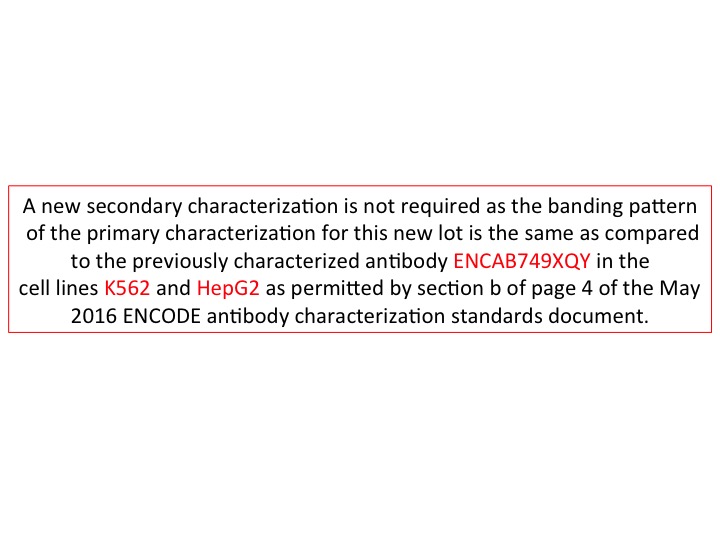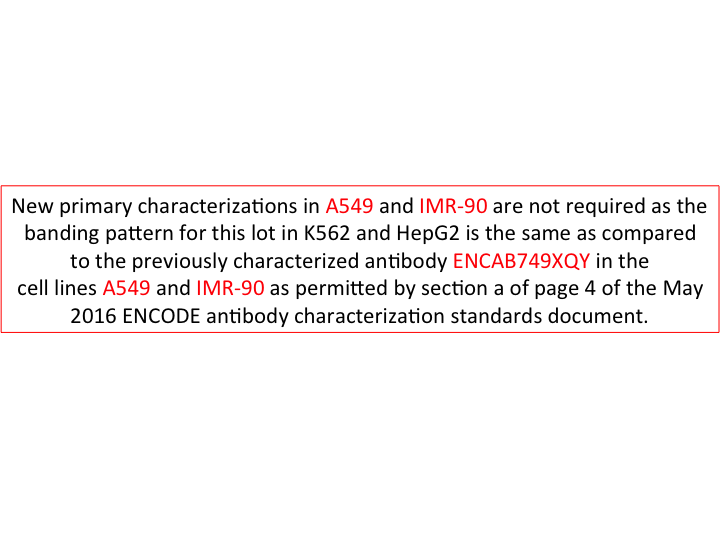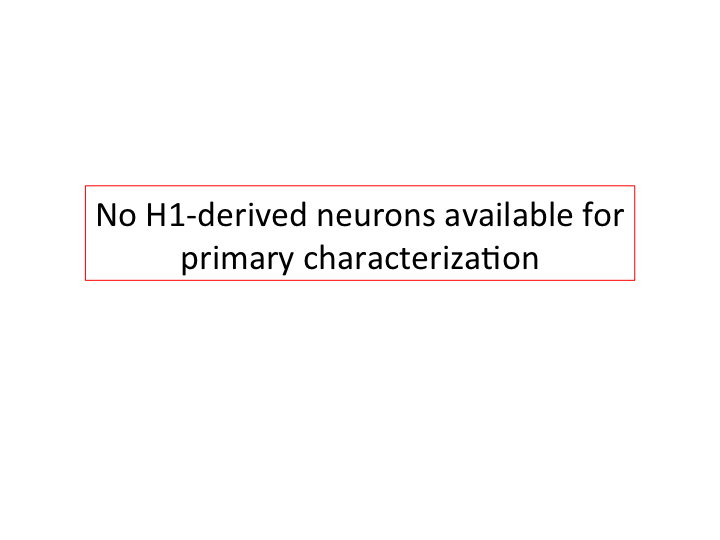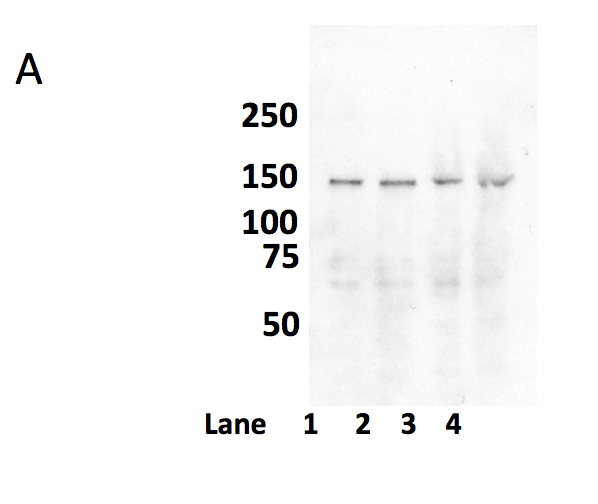ENCAB000AKX
Antibody against Homo sapiens SMC3, Mus musculus SMC3
Homo sapiens
GM12878, K562, HeLa-S3, HepG2, neural cell, A549, IMR-90
characterized to standards with exemption
Homo sapiens
any cell type or tissue
partially characterized
Mus musculus
any cell type or tissue
partially characterized
- Status
- released
- Source (vendor)
- Abcam
- Product ID
- ab9263
- Lot ID
- 963667
- Characterized targets
- SMC3 (Homo sapiens), SMC3 (Mus musculus)
- Host
- rabbit
- Clonality
- polyclonal
- Purification
- affinity
- Antigen description
- Raised against synthetic peptide representing a portion within the last 100 amino acids of the human Structural Maintenance of Chromosomes-3 conjugated to KLH.
- External resources
Characterizations
SMC3 (Homo sapiens)
exempt from standards
- Caption
- A new secondary characterization is not required as one exists for ENCAB749XQY which is a lot of the same antibody (ab9263). The primary characterization of K562 and HepG2 for this lot (https://www.encodeproject.org/antibody-characterizations/3520cc2e-c067-4df0-9d68-7f61744a75f5/) shows the same banding pattern as the primary characterization (https://www.encodeproject.org/antibody-characterizations/b1ccde77-1ec6-4eb3-8930-2dd9fe002bcd/ https://www.encodeproject.org/antibody-characterizations/a8ff6fa7-7588-4417-b7d4-869333e1d381/) for the same respective cell lines for the lot ENCAB749XQY.
- Submitter comment
- This is a new lot of a previously characterized antibody ENCAB749XQY and we think no further characterization is necessary beyond the primary if the banding pattern is consistent with the old.
- Reviewer comment
- The banding pattern in K562 and HepG2 is consistent with that of the primary characterizations associated with old lot ENCAB749XQY so a new secondary characterization for the new lot is not needed.
- Submitted by
- Esther Chan
- Lab
- Michael Snyder, Stanford
- Grant
- U54HG006996
- Download
- ENCAB000AKX_secondary.jpg
SMC3 (Homo sapiens)
A549IMR-90
exempt from standards
- Caption
- New primary characterizations for A549 and IMR-90 are not required as the banding pattern for characterized cell lines in common (K562 and HepG2) with another fully characterized lot ENCAB749XQY of the same antibody (ab9263). Primary characterizations of ENCAB749XQY in A549 and IMR-90 also exhibit the same banding pattern.
- Submitter comment
- We think this antibody lot should be exempted from primary characterization in A549 and IMR-90 as we've demonstrated that the lot behaves the same in immunoprecipitations as another lot (ENCAB749XQY) in those and other cell types.
- Reviewer comment
- This antibody was exempted from primary characterization in A549 and IMR-90 by the ENCODE antibody review panel on October 17, 2016.
- Submitted by
- Jessika Adrian
- Lab
- Michael Snyder, Stanford
- Grant
- U54HG006996
- Download
- ENCAB000AXU_primary_A549_IMR90.png
SMC3 (Homo sapiens)
neural cell
exempt from standards
- Caption
- The ENCODE antibody standards document exempts some valuable and/or limiting samples from primary characterizations for well-characterized antibodies. They are given exemptions so that the samples can be conserved to carry out the downstream experiments.
- Submitter comment
- We do not have any of the H1-derived neurons that were distributed to the consortium for analysis in ENCODE2 left.
- Reviewer comment
- This cell type was exempted from primary characterization of antibody ENCAB000AKX by the ENCODE antibody review panel on October 17, 2016
- Submitted by
- Jessika Adrian
- Lab
- Michael Snyder, Stanford
- Grant
- U54HG006996
- Download
- H1neuron_primary.png
SMC3 (Homo sapiens)
GM12878K562HeLa-S3HepG2
compliant
- Caption
- A. Western blot using ab9263. Lanes contain nuclear lysates from GM12878 cells (Lane 1), K562 cells (Lane 2), HeLa S3 cells (Lane 3), and HepG2 cells (Lane 4).
- Submitted by
- Kathrina Onate
- Lab
- Michael Snyder, Stanford
- Grant
- U54HG004558
- Download
- human SMC3 WB.png
SMC3 (Homo sapiens)
Method: immunoprecipitation
not reviewed
- Submitted by
- Michael Snyder
- Lab
- Michael Snyder, Stanford
- Grant
- U54HG004558
- Download
- human_SMC3_validation_Snyder.pdf
SMC3 (Homo sapiens)
Method: ChIP-seq comparison
not reviewed
- Submitted by
- Michael Snyder
- Lab
- Michael Snyder, Stanford
- Grant
- U54HG004558
- Download
- human_SMC3_validation_Snyder.pdf
SMC3 (Mus musculus)
Method: ChIP-seq comparison
not reviewed
- Submitted by
- Michael Snyder
- Lab
- Michael Snyder, Stanford
- Grant
- RC2HG005602
- Download
- mouse_SMC3_validation_Snyder.pdf
SMC3 (Mus musculus)
Method: immunoprecipitation
not reviewed
- Submitted by
- Michael Snyder
- Lab
- Michael Snyder, Stanford
- Grant
- RC2HG005602
- Download
- mouse_SMC3_validation_Snyder.pdf



